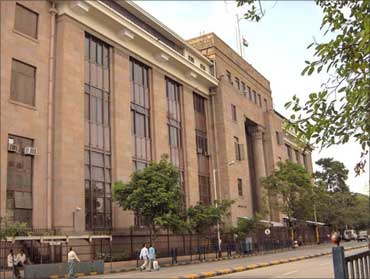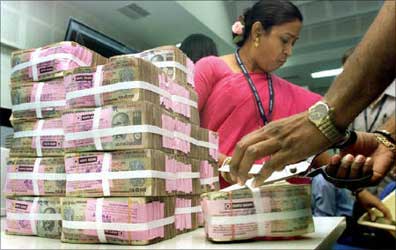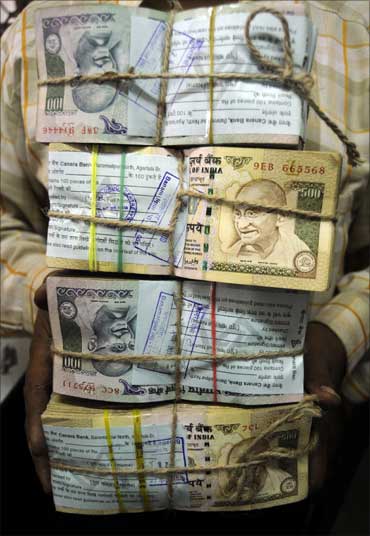 | « Back to article | Print this article |
Budget: Everything you wanted to know about it
The Union Budget is the single-most important event in India's economic and financial world, although many economists believe that it has lost, or is losing, its significance given that in today's dynamic economic environment, the government needs to take quick remedial steps in response to a fast-changing global scenario.
Be that as it may, the Budget still remains a very important event for India. But just what is the Budget?
Why is it so important? Why does it affect all of us?
And, above all, how does one interpret the budgetary lingo flying around? By the way, the finance minister will announce the Budget proposals for 2011-2012 on Monday, February 28.
Click NEXT to read on . . .
Budget: Everything you wanted to know about it
The Union Budget is the annual report of India as a country. It contains the government of India's revenue and expenditure for the end of a particular fiscal year, which runs from April 1 to March 31.
The Union Budget is the most extensive account of the government's finances, in which revenues from all sources and expenses of all activities undertaken are aggregated. It comprises the revenue budget and the capital budget. It also contains estimates for the next fiscal year.
What is a revenue budget?
The revenue budget consists of revenue receipts of the government (revenues from tax and other sources), and its expenditure.
Revenue receipts are divided into tax and non-tax revenue.
Tax revenues are made up of taxes such as income tax, corporate tax, excise, customs and other duties that the government levies.
In non-tax revenue, the government's sources are interest on loans and dividend on investments like PSUs, fees, and other receipts for services that it renders.
Revenue expenditure is the payment incurred for the normal day-to-day running of government departments and various services that it offers to its citizens.
Click NEXT to read on . . .
Budget: Everything you wanted to know about it
The government also has other expenditure like servicing interest on its borrowings, subsidies, etc.
Usually, expenditure that does not result in the creation of assets, and grants given to state governments and other parties are revenue expenditures.
The difference between revenue receipts and revenue expenditure is usually negative. This means that the government spends more than it earns. This difference is called the revenue deficit.
What is a capital budget?
The capital budget is different from the revenue budget as its components are of a long-term nature.
The capital budget consists of capital receipts and payments.
Capital receipts are government loans raised from the public, government borrowings from the Reserve Bank and treasury bills, loans received from foreign bodies and governments, divestment of equity holding in public sector enterprises, securities against small savings, state provident funds, and special deposits.
Capital payments are capital expenditures on acquisition of assets like land, buildings, machinery, and equipment. Investments in shares, loans and advances granted by the central government to state and union territory governments, government companies, corporations and other parties.
Click NEXT to read on . . .
Budget: Everything you wanted to know about it
What are direct taxes?
These are the taxes that are levied on the income of individuals or organisations. Income tax, corporate tax, inheritance tax are some instances of direct taxation.
Income tax is the tax levied on individual income from various sources like salaries, investments, interest etc.
Corporate tax is the tax paid by companies or firms on the incomes they earn.
Click NEXT to read on . . .
Budget: Everything you wanted to know about it
What are indirect taxes?
These are the taxes paid by consumers when they buy goods and services.
These include excise and customs duties.
Customs duty is the charge levied when goods are imported into the country, and is paid by the importer or exporter.
Excise duty is a levy paid by the manufacturer on items manufactured within the country.
Usually, these charges are passed on to the consumer.
Click NEXT to read on . . .
Budget: Everything you wanted to know about it
What is plan and non-plan expenditure?
There are two components of expenditure -- plan and non-plan.
Of these, plan expenditures are estimated after discussions between each of the ministries concerned and the Planning Commission.
Non-plan revenue expenditure is accounted for by interest payments, subsidies (mainly on food and fertilisers), wage and salary payments to government employees, grants to States and Union Territories governments, pensions, police, economic services in various sectors, other general services such as tax collection, social services, and grants to foreign governments.
Non-plan capital expenditure mainly includes defence, loans to public enterprises, loans to States, Union Territories and foreign governments.
Click NEXT to read on . . .
Budget: Everything you wanted to know about it
What is the Central Plan Outlay?
It is the division of monetary resources among the different sectors in the economy and the ministries of the government.
What is fiscal policy?
Fiscal policy is a change in government spending or taxing designed to influence economic activity. These changes are designed to control the level of aggregate demand in the economy.
Governments usually bring about changes in taxation, volume of spending, and size of the budget deficit or surplus to affect public expenditure.
Click NEXT to read on . . .
Budget: Everything you wanted to know about it
What is a fiscal deficit?
This is the gap between the government's total spending and the sum of its revenue receipts and non-debt capital receipts. It represents the total amount of borrowed funds required by the government to completely meet its expenditure.
What is the Finance Bill?
The government proposals for the levy of new taxes, alterations in the present tax structure or continuance of the current tax structure beyond the period approved by the Parliament, are laid down before the Parliament in this bill.
The Parliament approves the Finance Bill for a period of one year at a time, which becomes the Finance Act.
Click NEXT to read on . . .
Budget: Everything you wanted to know about it
What impact does the Budget have on the market and economy?
The Budget impacts the economy, the interest rate and the stock markets. How the finance minister spends and invests money affects the fiscal deficit. The extent of the deficit and the means of financing it influence the money supply and the interest rate in the economy. High interest rates mean higher cost of capital for the industry, lower profits and hence lower stock prices.
The fiscal measures undertaken by the government affect public expenditure. For instance, an increase in direct taxes would decrease disposable income, thus reducing demand for goods. This decrease in demand will translate into a decrease in production, therefore affecting economic growth.
Similarly, an increase in indirect taxes would also decrease demand. This is because indirect taxes are often partially or completely passed on to consumers in the form of higher prices. Higher prices imply a reduction in demand and this in turn would reduce profit margins of companies, thus slowing down production and growth.
Non-plan expenditure like subsidies and defence also affect the economy as limited government resources are used for non-productive purposes.
Click NEXT to read on . . .









